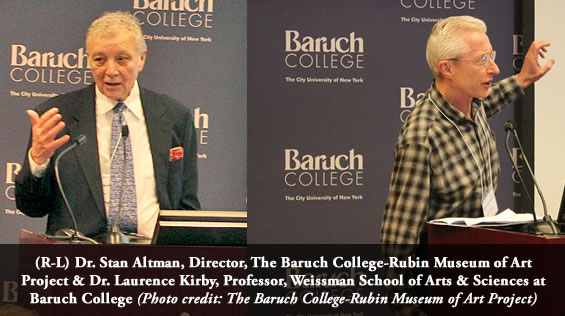Higher Education, Museums, and Technology: the 21st Century Formula for Innovation
By Mohammad Ibrar

Emphasis on STEM education has been pushed forward by the Obama administration, military, technology sector, and education experts, citing that STEM education will lead to economic growth and stability. Yet, there is a growing trend of collaboration between colleges and museums, which claim an arts integrated education will accomplish the same feat. Recently, Baruch College and the Rubin Museum of Art hosted a conference that outlined the great strides in innovation and development that is garnered through partnerships between higher-education institutions and museums around the globe.
The conference provided an umbrella for all of the new initiatives, research, and ground-breaking projects established through the various relationships, all of which underscored the positive effects the arts and culture can have on the students and help prepare them for a career in the 21st Century.
A multitude of studies indicate that increased exposure to arts and culture in college and high school enhances students’ overall learning capacity, creativity, social awareness, critical-thinking and communication skills — all prime qualities employers seek in potential candidates. Initial results from comprehensive study still underway by Deb Mexicott, assistant director of arts at University of Michigan, showed that students with minimal involvement in arts deemed themselves as creative, efficient problem solvers, and confident communicators, compared to students with no involvement in arts in high school. According to research conducted by the National Governors Association in 2002, students who study the arts are four times more likely to be recognized for academic achievement, and four times more likely to participate in a math or science fair. Moreover, results illustrated a strong correlation between arts education to “academic and personal success.”
Exposure to the arts also integrates project-based learning as well as object-based learning — both have positive effects on learners. Dr. Leonie Hannan, a teaching fellow at University of College London, a forerunner of museum and higher education collaboration, explained that 67 percent of students’ found object based learning more engaging and effective than listening to a lecture. Furthermore, nearly 35 percent of students agreed that hands-on learning aids in the understanding and acquisition of knowledge, whereas, 1.6 percent reported no positive gains. The studies provide hard facts that museums and the arts can provide stimulating learning environments for students.
Museums, colleges, and education organization are first to utilize this information innovatively. With technology, the movement has gone viral: the American Museum of Natural History recently partnered with Coursera; Smarthistory by Khan Academy, an open educational resource, has reported over six million unique visits and continues to grow exponentially; Columbia University incorporated the Rubin Museum’s digital art collection into its core curriculum. “This is a step toward creating global citizens in an interdependent world,” said Stan Altman, director of the Baruch College-Rubin Museum of Art Project.
Educators are taking note and find themselves at the fore of the trailblazing efforts. Dr. Janice Robertson, associate professor at Pratt Institute, described the ubiquity of PowerPoint slideshows in art history classes, and how art students “are bored to death.” She has effectively implemented Voice Thread, a multimedia cloud application, in all of her classes. The multimedia accessibility boosted student-to-student collaboration. “I saw students becoming more passionate about art … sharing ideas, questioning ideas and being more engaged,” said Robertson. “Art became fun.”
Many professors unfamiliar with teaching museum material welcome the new practice and expressed positive experiences in and out their classrooms. Professor Laurence Kirby, a 2012-2013-faculty fellow in the Baruch-Rubin Art Project, teaches mathematics and failed to see a stretch between math and art; rather, he said that the two subjects “naturally complement each other.”
The Baruch-Rubin Art Project mission is to do exactly just that: “encourage innovation in educational experiences…to enrich student experiences by creatively integrating arts across curricula.” The art project started in 2010 and has grown to include five CUNY colleges and provides financial support for faculty members interested in arts immersion. In 2012, recorded college attendance at the Rubin Museum peaked to nearly 9,500 visits, with group or class visits accounting for 53 percent. What is more, the project has successfully intertwined Rubin Museum’s collections into ten distinct disciplines ranging from Business to Law and from Anthropology to Political Science. The project is flourishing and has inspired neighboring universities such as SUNY to do the same. “We hope the project can serve as a model for others,” said Altman. #
